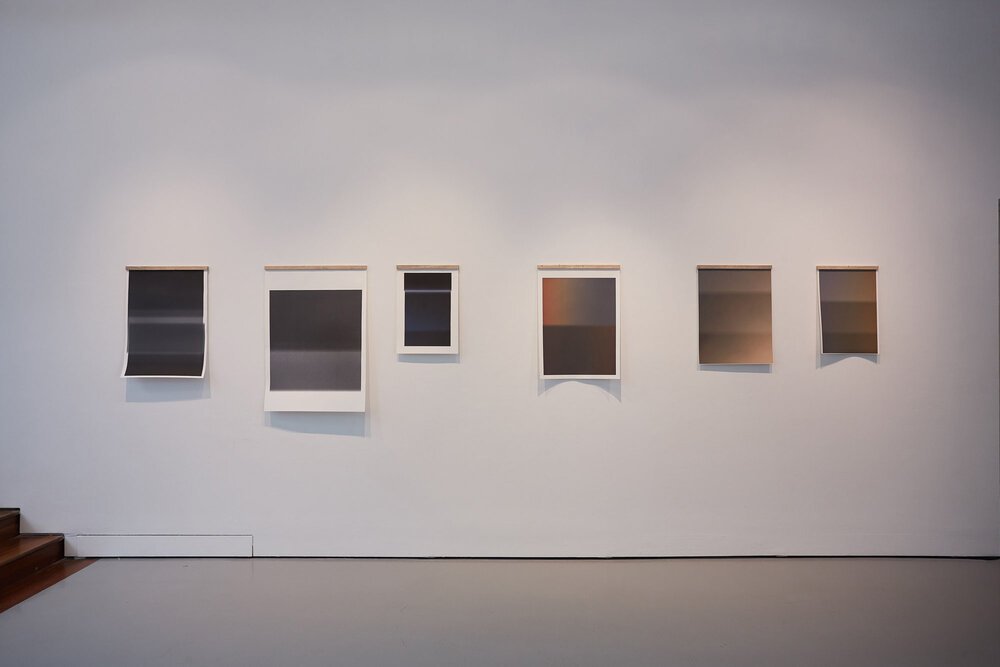Liu Liling
Meditations on time and image
By Ian Tee
Liu Liling, works from ‘Horizon’ series, exhibition view in ‘The Fabric of Sympathy’, 12 September - 10 October 2020. Image courtesy of Institute of Contemporary Arts, Singapore, LASALLE College of the Arts. Photograph by Wong Jing Wei.
One often thinks of a photograph as a snapshot that collapses time into a single moment, a single image. Henri Cartier-Bresson described this as “the decisive moment” in classic point-and-shoot photography. Singapore artist Liu Liling hopes to suspend our understanding of time through the use of the camera and the photographic medium. Her work challenges the immediacy of digital imaging, finding ways to extend the duration taken to produce an image on the printed surface. The experience of seeing her “slow images” is a gradual unfolding of layers that offer restful moments of pause.
Liu Liling, ‘Horizon: Hale-Slate-II’, 2019, inkjet print on smooth cotton rag, 76 x 56cm. Image courtesy of the artist.
Liu Liling, ‘Horizon: Bricktone’, 2019, inkjet print on smooth cotton rag, 59.4 x 42cm. Image courtesy of the artist.
Liling’s use of the inkjet printer as an artistic tool complicates the binary of digital versus analogue. To create the ‘Horizon’ series (2019-ongoing), her method involves superimposing solid planes of colour, by halting and repeating the printing process. The resultant images are varied: they could be monochromatic or a colour field of gradient hues. What connects them are distinct horizon lines that seem to recede into deep space, suggesting a landscape or a view where the sky meets the sea.
These are intimate images that draw audiences in for close viewing. To this end, the artist presents the prints unframed, without a glass barrier between the viewer and artwork. Such a presentation highlights the tactility of paper and its porous nature as a printed surface. Indeed, upon inspection, one notices charming “imperfections” such as misaligned registrations, pockmarks, smudges or streaks of ink. These traces are retained not simply as products of chance, but a recognition of the interaction between material and process.
“Such a presentation highlights the tactility of paper and its porosity as a printed surface.”
Liu Liling, ‘One October Day’, 2019, inkjet print on transparency film, dimensions variable. Image courtesy of the artist.
Liling’s interest in the material substrate is also explored in ‘One October Day’ (2019), a work that precedes the ‘Horizon’ series. In this piece, she played with the surface’s porosity and printed a digital photograph on transparency film. Instead of being absorbed into the substrate, the ink stayed wet on the film surface, thus creating a highly delicate print which responded to atmospheric conditions. It became a photographic surface that allowed for a buildup of material, where old and new marks collapse onto the same picture plane. Gradually, the image becomes dissolved as dust particles collect on the surface and the wet ink separates. Time continues to be recorded long after the digital photo was taken.
Liu Liling, ‘Haze’, 2021, installation view at I_S_L_A_N_D_S, 3 – 30 September 2021. Image courtesy of Chua Chye Teck.
The incorporation of backlighting is a new element in Liling’s first solo presentation ‘Haze’ (2021). Produced based on dimensions of a column in the exhibition space, the lightbox’s narrow format and repeating composition also recall the look of film rolls. The alternating bands of coral red and saturated purple reference colours observed across daybreak through nightfall, and have a calm, almost hypnotic quality. The artist describes this effect eloquently as “a visual rhythm akin to the state between one’s wakefulness and sleep.”
Click here to read our dialogue with Liu Liling.


















